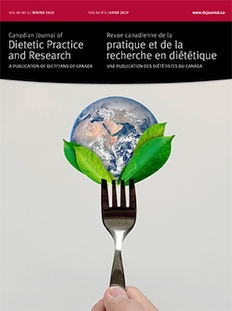Abstract
Purpose: In 2010, Health Canada implemented a national campaign to improve understanding of “percent daily value” (%DV) in Nutrition Facts Tables (NFTs). This study examined sources of nutrition information and knowledge of %DV information communicated in the campaign.
Methods: Respondents aged 16–30 years completed the Canada Food Study in 2016 (n = 2665). Measures included sources of nutrition information, NFT use, and %DV knowledge based on the campaign message (“5% DV or less is a little; 15% DV or more is a lot”). A logistic regression examined correlates of providing “correct” responses to %DV questions related to the campaign messaging.
Results: Overall, 7.2% (n = 191) respondents correctly indicated that 5% is “a little”, and 4.3% (n = 115) correctly indicated 15% DV was “a lot”. Only 4.0% (n = 107) correctly answered both. Correct recall of %DV amounts was not associated with number of information sources reported, but was greater among those who were female, were younger, and reported greater NFT understanding and serving size information use (P < 0.05 for all).
Conclusions: Results show low awareness of messaging from the Nutrition Facts Education Campaign among young Canadians. Such a mass media campaign may be insufficient on its own to enhance population-level understanding of %DV.
Résumé
Objectif. En 2010, Santé Canada a mis en œuvre une campagne nationale visant à améliorer la compréhension du « pourcentage de la valeur quotidienne » (% VQ) des tableaux de la valeur nutritive (TVN). Cette étude avait pour but d’examiner les sources d’information nutritionnelle et les connaissances relatives à l’information sur le % VQ communiquée dans le cadre de la campagne.
Méthodes. Les répondants âgés de 16 à 30 ans ont participé à l’Étude sur les aliments au Canada en 2016 (n = 2 665). Les mesures comprenaient les sources d’information nutritionnelle, l’utilisation des TVN et les connaissances sur le % VQ sur la base du message véhiculé lors de la campagne (« 5 % VQ ou moins, c’est peu; 15 % VQ ou plus, c’est beaucoup »). Une régression logistique a été utilisée pour examiner la corrélation entre des réponses « correctes » aux questions sur le % VQ et les messages de la campagne.
Résultats. Dans l’ensemble, 7,2 % (n = 191) des répondants ont correctement indiqué que 5 % représentait « peu » et 4,3 % (n = 115) ont correctement indiqué que 15 % VQ était « beaucoup ». Seulement 4,0 % (n = 107) ont répondu correctement aux deux questions. Le fait de se souvenir des cibles de % VQ n’était pas associé au nombre de sources d’information indiqué, mais les femmes, les jeunes et les personnes qui ont déclaré mieux comprendre les TVN et se servir de l’information sur la taille des portions (P < 0,05 en tout) s’en souvenaient davantage.
Conclusions. Les résultats montrent que les jeunes canadiens sont peu sensibilisés aux messages véhiculés dans la Campagne d’éducation sur le tableau de la valeur nutritive. Une telle campagne de médias de masse ne suffirait peut-être pas à elle seule à améliorer le niveau de compréhension de la population quant au % DV.



